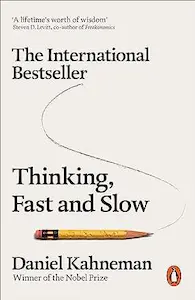Thinking, Fast and Slow - Summary
Daniel Kahneman

Introduction
“Thinking, Fast and Slow” is a book written by Nobel Prize-winning economist Daniel Kahneman. The book is a comprehensive exploration of the human mind and how it processes information. In this book, Kahneman introduces two systems of thinking that we use to make decisions: System 1 and System 2. System 1 is the fast, automatic, and intuitive system, while System 2 is the slow, deliberate, and logical system. Throughout the book, Kahneman provides numerous examples and anecdotes to illustrate how these two systems work and how they can lead to errors in judgment and decision-making.
System 1 and System 2
Kahneman begins the book by introducing the concept of System 1 and System 2 thinking. System 1 thinking is the fast, automatic, and intuitive system that operates without conscious effort. It is responsible for our quick reactions to stimuli and our ability to make snap judgments. System 2 thinking, on the other hand, is the slow, deliberate, and logical system that requires conscious effort. It is responsible for our ability to reason, plan, and solve problems.
Kahneman explains that System 1 thinking is prone to errors because it relies on heuristics, or mental shortcuts, that can lead to biases and mistakes. For example, System 1 thinking can lead us to make judgments based on stereotypes or to overestimate the likelihood of rare events. System 2 thinking, on the other hand, is less prone to errors because it is more deliberate and logical. However, it is also more effortful and can be easily overwhelmed by cognitive load.
Anchoring Effect
One of the most interesting concepts that Kahneman discusses in the book is the anchoring effect. The anchoring effect is a cognitive bias that occurs when people rely too heavily on the first piece of information they receive when making decisions. For example, if you are asked to estimate the number of countries in Africa, and the first number you hear is 50, you are likely to give a higher estimate than if you had heard the number 10.
Kahneman provides several examples of the anchoring effect in action, including a study in which people were asked to estimate the percentage of African countries that were members of the United Nations. When the researchers first asked participants to spin a wheel of fortune, which had numbers ranging from 0 to 100, and then asked them to estimate the percentage, they found that the estimates were influenced by the number on the wheel.
Availability Heuristic
Another important concept that Kahneman discusses is the availability heuristic. The availability heuristic is a mental shortcut that occurs when people make judgments based on the ease with which examples come to mind. For example, if you are asked to estimate the likelihood of a shark attack, you are likely to overestimate the risk if you have recently seen a news report about a shark attack.
Kahneman provides several examples of the availability heuristic in action, including a study in which people were asked to estimate the likelihood of various causes of death. Participants tended to overestimate the likelihood of rare causes of death, such as terrorism or homicide, because these events are more memorable and therefore more available in their minds.
Confirmation Bias
Confirmation bias is another important concept that Kahneman discusses in the book. Confirmation bias occurs when people seek out information that confirms their existing beliefs and ignore information that contradicts them. This can lead to errors in judgment and decision-making because it can prevent people from considering alternative viewpoints or evidence.
Kahneman provides several examples of confirmation bias in action, including a study in which people were asked to evaluate the effectiveness of a new therapy for a particular disease. Participants who were told that the therapy was effective tended to ignore evidence to the contrary and were more likely to recommend the therapy than those who were not given this information.
Conclusion
“Thinking, Fast and Slow” is a fascinating exploration of the human mind and how it processes information. Kahneman’s introduction of System 1 and System 2 thinking provides a useful framework for understanding how we make decisions and why we sometimes make errors in judgment. The book is filled with numerous examples and anecdotes that illustrate the concepts and make them easy to understand. Overall, “Thinking, Fast and Slow” is a must-read for anyone interested in psychology, economics, or decision-making.